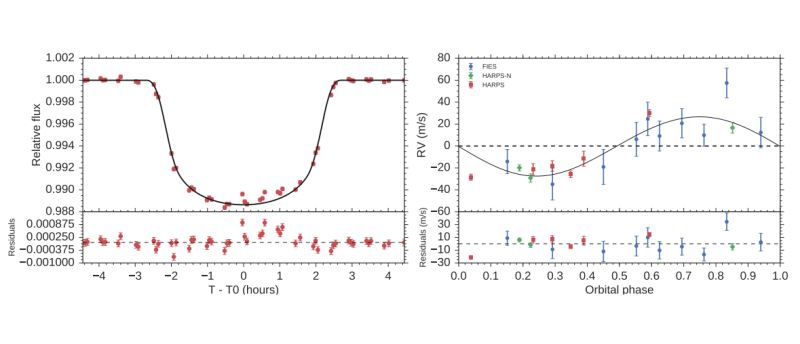February 6, 2017 report
Astronomers discover the least massive warm Jupiter exoplanet

(Phys.org)—A European team of astronomers led by Oscar Barragán of the University of Turin in Italy reports the discovery of a low-mass warm Jupiter extrasolar planet orbiting a nearby K-type main-sequence star. The newly found alien world, designated EPIC 218916923b, is the least massive warm Jupiter known to date. The findings were presented Feb. 2 in a paper published on arXiv.org.
The new planet was first detected by NASA's Kepler spacecraft during its prolonged mission known as K2. The K2 Campaign 7, which was conducted between Oct. 4 and Dec. 26, 2015, obtained a transit signal associated with the star EPIC 218916923. It is an active K0 V star located some 500 light years away.
"We herein present the discovery of EPIC 218916923b, a transiting warm Jupiter in a 29-day orbit around an active K0 V star that has been photometrically monitored by the K2 space mission during its Campaign 7," the researchers wrote in the paper.
In order to confirm the planetary nature of the transit signal, the team conducted follow-up observations utilizing ground-based observatories. The scientists made use of the 2.56-m Nordic Optical Telescope (NOT), the 3.58-m Telescopio Nazionale Galileo (TNG) (both located at the Roque de los Muchachos Observatory in La Palma, Canary Islands, Spain), the 2.7-m telescope at McDonald Observatory (Texas, USA) and the ESO 3.6-m Telescope of La Silla Observatory (Chile).
The astronomers managed to derive the main parameters of the system. According to the study, EPIC 218916923b has a radius of about 0.81 Jupiter radii, but has only 38 percent of Jupiter's mass. The researchers also estimated that the exoworld orbits its parent star approximately every 29 days and is about 12 percent less dense than the solar system's biggest planet.
Moreover, the scientists assume that the planet has a core with a mass of about 48 Earth masses, containing some 40 percent of the total planetary mass. They also expect that the newly detected extrasolar world has a solid core surrounded by a gaseous envelope.
Given the fact that EPIC 218916923b is a gas giant planet and taking into account its orbital period, this planet was classified as a warm Jupiter. The so-called "warm Jupiters" are gas giant planets with a minimal mass of 0.3 Jupiter masses and orbital periods ranging between 10 and 100 days. They mark the transition between "hot Jupiters" with orbital period between one and 10 days and Jupiter analogues with orbital period longer than 100 days.
EPIC 218916923b is the newest addition to the list of 80 warm Jupiters known so far. According to the paper, this planet also joins the small group of well-characterized warm Jupiters whose mass and radius have been determined with a precision better than 25 percent.
The team concluded that the discovery of EPIC 218916923b marks another important step toward better characterization of the population of warm Jupiters in terms of planetary mass, radius and orbital parameters. It could be also helpful in testing different planet formation mechanisms.
More information: EPIC 218916923 b: a low-mass warm Jupiter on a 29-day orbit transiting an active K0 V star, arXiv:1702.00691 [astro-ph.EP] arxiv.org/abs/1702.00691
Abstract
We announce the discovery of EPIC218916923 b, a transiting warm-Jupiter (Teq=555±11 K) on a 29-day orbit around an active (logR′HK = −4.49 ± 0.03) K0 V star in K2 Campaign 7. We derive the system's parameters by combining the K2 photometry with ground-based follow-up observations. With a mass of Mp=0.381±0.045MJup and radius of Rp=0.812±0.030RJup, EPIC218916923 b is one of the transiting warm Jupiters with the lowest mass known to date. The planetary mean density ρp=0.88±0.14gcm−3 can be explained with a core of ∼50M⊕. Given the brightness of the host star (V= 11.653 mag), the relatively short transit duration (∼5 hours), and the expected amplitude of the Rossiter-McLaughlin effect (∼25 ms), EPIC218916923 is an ideal target to measure the spin-orbit angle of a planetary system hosting a warm Jupiter.
© 2017 Phys.org



















